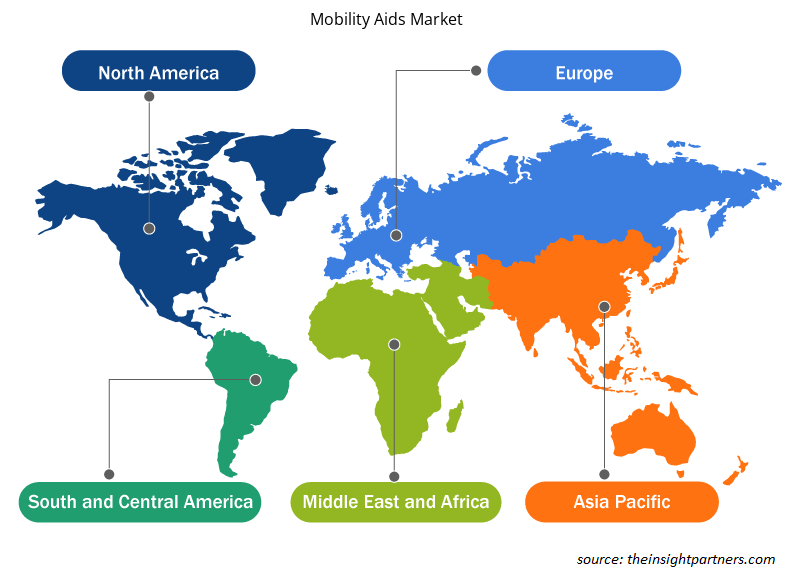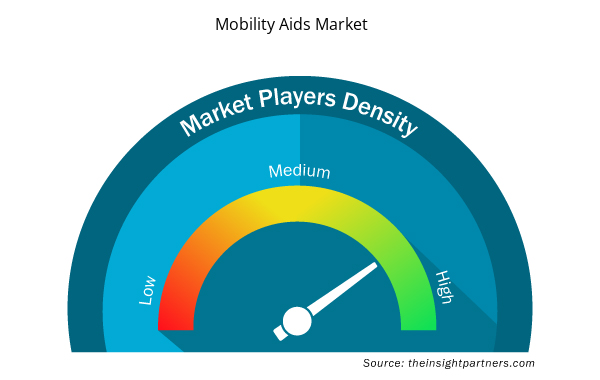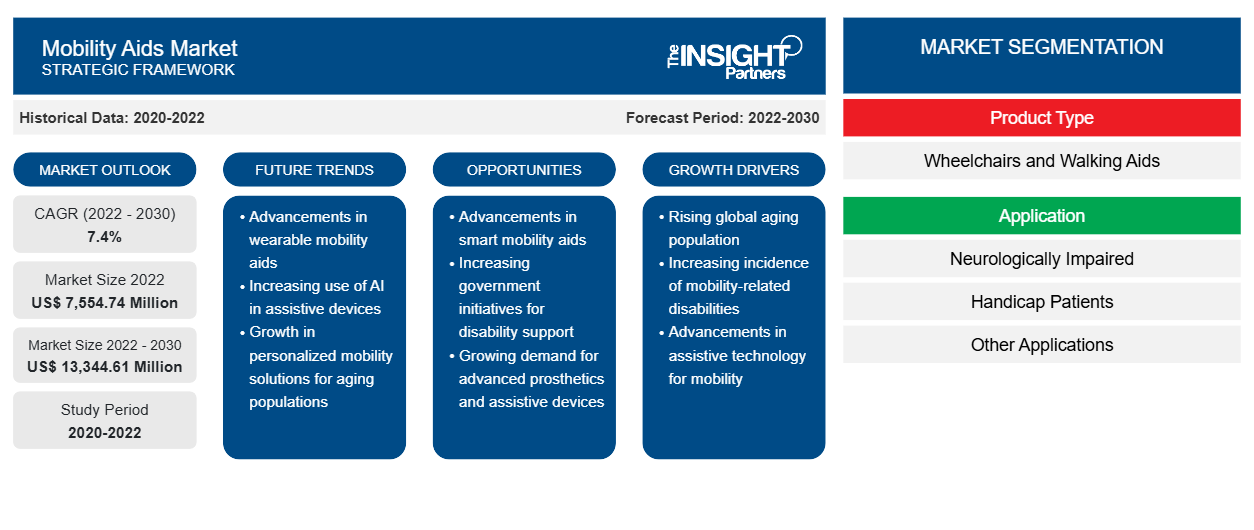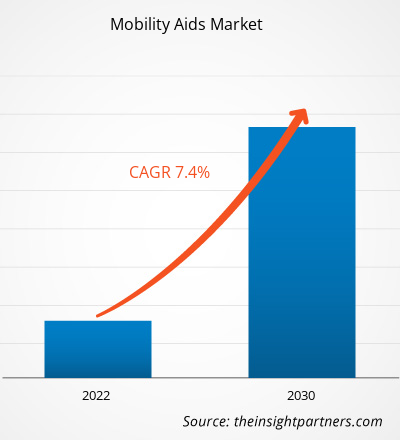[Forschungsbericht] Der Markt für Mobilitätshilfen soll von 7.554,74 Millionen US-Dollar im Jahr 2022 auf 13.344,61 Millionen US-Dollar im Jahr 2030 wachsen; für den Zeitraum 2022–2030 wird eine durchschnittliche jährliche Wachstumsrate (CAGR) von 7,4 % erwartet.
Markteinblicke und Analystenansichten:
Eine Mobilitätshilfe ist ein Hilfsmittel, das Menschen mit Mobilitätsproblemen beim Gehen hilft; diese Hilfsmittel können auch von Menschen verwendet werden, um ihre Mobilität zu verbessern. Mobilitätshilfen sollen älteren und behinderten Menschen das Fortbewegen erleichtern. Darüber hinaus können Patienten, die in ihrer häuslichen Pflegeumgebung Schwierigkeiten haben, sich fortzubewegen, mithilfe dieser Hilfsmittel transportiert werden. Schienen, Gehstöcke, Krücken und Rollatoren sind einige Beispiele für Mobilitätshilfen. Zu Gehhilfen zählen Krücken, Rollatoren und Gehstöcke, die allgemein als Spazierstöcke bezeichnet werden. Diese Geräte können für verbesserte Stabilität, geringere Belastung der unteren Gliedmaßen und/oder Bewegungserzeugung sorgen, was dabei hilft, aufrecht zu gehen.
Wachstumstreiber:
Mit zunehmendem Alter werden Menschen anfälliger für Mobilitätseinschränkungen, aufgrund derer sie medizinische Hilfe oder Unterstützung benötigen, um nicht von anderen Menschen abhängig zu sein. Die Weltbevölkerung altert schnell, und die Zahl älterer Erwachsener wird in den kommenden Jahren voraussichtlich erheblich steigen. Die meisten Menschen gehen davon aus, 60 Jahre oder älter zu werden. Laut einer Studie der Weltgesundheitsorganisation (WHO) aus dem Jahr 2021 wird die Bevölkerung der über 60-Jährigen voraussichtlich von 900 Millionen im Jahr 2021 auf 2 Milliarden im Jahr 2050 anwachsen. Der Anteil der über 60-Jährigen an der Weltbevölkerung würde sich von 12 % im Jahr 2015 auf 22 % im Jahr 2050 fast verdoppeln.
Laut den Bevölkerungsstatistiken des Census Bureau von 2020 betrug die Zahl der geriatrischen Menschen in den USA im Jahr 2020 55,8 Millionen (16,8 %) der Gesamtbevölkerung. Die Zahl der über 65-Jährigen wird zwischen 2012 und 2050 voraussichtlich stark ansteigen. Fast jeder Sechste im Land war 2020 65 Jahre oder älter. Laut den vom Fraser Institute veröffentlichten Daten stieg der Anteil der über 65-Jährigen in Kanada von 14 % im Jahr 2010 auf 19 % im Jahr 2022 und soll bis 2030 sogar 22,5 % erreichen.
In Brasilien nimmt die alternde Bevölkerung rapide zu. Laut Angaben der Panamerikanischen Gesundheitsorganisation (PAHO) leben in Brasilien über 30 Millionen Menschen im Alter von 60 Jahren und älter (also 13 % der Bevölkerung des Landes). Bis 2030 wird die Bevölkerung dieser Altersgruppe voraussichtlich auf etwa 50 Millionen anwachsen (also 24 % der Gesamtbevölkerung). Laut dem brasilianischen Statistikinstitut werden Menschen im Alter von 65 Jahren und älter bis 2050 voraussichtlich einen Anteil von 36 % an der Gesamtbevölkerung Brasiliens ausmachen. Ebenso war laut Eurostat-Statistik im Jahr 2022 über ein Fünftel (~21 %) der europäischen Bevölkerung 65 Jahre und älter.
Ältere Menschen leiden häufig unter Problemen wie Muskelschwäche, Gleichgewichtsstörungen und Gelenkproblemen, die es ihnen erschweren, sich selbstständig fortzubewegen. Diese Hilfsmittel wie Gehhilfen, Stöcke und Rollstühle bieten ihnen Halt und Hilfe. Diese Hilfsmittel können das Verletzungsrisiko verringern, Stürzen vorbeugen und älteren Menschen ermöglichen, aktiv zu bleiben und sich an ihren täglichen Aktivitäten zu beteiligen. Daher treibt die steigende Zahl älterer Menschen das Wachstum des Marktes für Mobilitätshilfen voran .
Passen Sie diesen Bericht Ihren Anforderungen an
Sie erhalten kostenlos individuelle Anpassungen an jedem Bericht, einschließlich Teilen dieses Berichts oder einer Analyse auf Länderebene, eines Excel-Datenpakets sowie tolle Angebote und Rabatte für Start-ups und Universitäten.
- Holen Sie sich die wichtigsten Markttrends aus diesem Bericht.Dieses KOSTENLOSE Beispiel umfasst eine Datenanalyse von Markttrends bis hin zu Schätzungen und Prognosen.
Berichtssegmentierung und -umfang:
Der Markt für Mobilitätshilfen ist nach Produkttyp, Anwendung, Endnutzer, Vertriebskanal und Geografie segmentiert. Basierend auf dem Produkttyp ist der Markt für Mobilitätshilfen in Rollstühle und Gehhilfen unterteilt. Basierend auf der Anwendung ist der Markt für Mobilitätshilfen in neurologisch beeinträchtigte, behinderte Patienten und andere Anwendungen unterteilt. Der Markt für Mobilitätshilfen ist nach Endnutzer in häusliche Pflege, Krankenhäuser und Kliniken, Rehabilitationszentren und ambulante chirurgische Zentren unterteilt. Basierend auf dem Vertriebskanal ist der Markt für Mobilitätshilfen in online und offline unterteilt. Basierend auf der Geografie ist der Markt für Mobilitätshilfen in Nordamerika (USA, Kanada und Mexiko), Europa (Frankreich, Deutschland, Großbritannien, Spanien, Italien und Rest von Europa), Asien-Pazifik (China, Indien, Japan, Australien, Südkorea und Rest von Asien-Pazifik), Naher Osten und Afrika (Saudi-Arabien, Vereinigte Arabische Emirate, Südafrika und Rest von Afrika) und Süd- und Mittelamerika (Brasilien, Argentinien und Rest von Süd- und Mittelamerika) segmentiert.
Segmentanalyse:
Der Markt für Mobilitätshilfen ist nach Produkttyp in Rollstühle und Gehhilfen unterteilt. Das Rollstuhlsegment hatte 2022 einen größeren Marktanteil und wird voraussichtlich zwischen 2022 und 2030 eine höhere durchschnittliche jährliche Wachstumsrate (CAGR) auf dem Markt verzeichnen.
Basierend auf der Anwendung ist der Markt für Mobilitätshilfen in neurologisch beeinträchtigte, behinderte Patienten und andere Anwendungen unterteilt. Im Jahr 2022 hielt das Segment der neurologisch beeinträchtigten Patienten den größten Marktanteil und wird voraussichtlich zwischen 2022 und 2030 die schnellste CAGR verzeichnen.
Basierend auf dem Endnutzer ist der Markt für Mobilitätshilfen in Heimpflege, Krankenhäuser und Kliniken, Rehabilitationszentren und ambulante chirurgische Zentren unterteilt. Das Segment Heimpflege hatte 2022 den größten Marktanteil. Das Segment Krankenhäuser und Kliniken wird voraussichtlich zwischen 2022 und 2030 die höchste durchschnittliche jährliche Wachstumsrate verzeichnen.
Basierend auf den Vertriebskanälen wird der Markt für Mobilitätshilfen in Online- und Offline-Markt unterteilt. Im Jahr 2022 hielt das Offline-Segment einen größeren Marktanteil. Es wird jedoch erwartet, dass das Online-Segment zwischen 2022 und 2030 mit einer höheren durchschnittlichen jährlichen Wachstumsrate wächst.
Regionale Analyse:
Der Markt für Mobilitätshilfen ist hauptsächlich in Nordamerika, Europa, Asien-Pazifik, Süd- und Mittelamerika sowie den Nahen Osten und Afrika unterteilt. Nordamerika eroberte 2022 einen bedeutenden Marktanteil. 2022 hielten die USA den größten Marktanteil in der Region. Das Marktwachstum in Nordamerika ist auf die steigende Zahl von Patienten mit diagnostizierten Mobilitätsstörungen und die wachsende geriatrische Bevölkerung zurückzuführen. Laut der Bevölkerungsabteilung der Vereinten Nationen wird die Zahl älterer Menschen in Mexiko bis 2050 voraussichtlich 30 Millionen erreichen. Laut dem National SCI Data Sheet 2022 werden in den USA jährlich fast 18.000 neue Fälle von Rückenmarksverletzungen (SCI) diagnostiziert. Die US-amerikanischen Rückenmarksverletzungsstatistiken für 2023 besagen, dass etwa 302.000 Menschen im Land eine traumatische SCI erlitten haben. In den USA sind die häufigsten Ursachen für SCI Autounfälle, Stürze, Gewalt und Sport.
Darüber hinaus brachte die Invacare Corporation (US) im März 2020 den Elektrorollstuhl Invacare AVIVA FX mit erstklassigem Design, Technologie und Leistung auf den Markt. Der Elektrorollstuhl AVIVA FX bietet aktuellen Benutzern von Frontantriebsfahrzeugen einen Hochleistungsrollstuhl, der einen innovativen Sprung nach vorne in der Elektromobilität mit Frontantrieb darstellt.
Regionale Einblicke in den Markt für Mobilitätshilfen
Die regionalen Trends und Faktoren, die den Markt für Mobilitätshilfen im Prognosezeitraum beeinflussen, wurden von den Analysten von Insight Partners ausführlich erläutert. In diesem Abschnitt werden auch die Marktsegmente und die Geografie für Mobilitätshilfen in Nordamerika, Europa, im asiatisch-pazifischen Raum, im Nahen Osten und Afrika sowie in Süd- und Mittelamerika erörtert.

- Erhalten Sie regionale Daten zum Markt für Mobilitätshilfen
Umfang des Marktberichts zu Mobilitätshilfen
| Berichtsattribut | Details |
|---|---|
| Marktgröße im Jahr 2022 | 7.554,74 Millionen US-Dollar |
| Marktgröße bis 2030 | 13.344,61 Millionen US-Dollar |
| Globale CAGR (2022 - 2030) | 7,4 % |
| Historische Daten | 2020-2022 |
| Prognosezeitraum | 2022–2030 |
| Abgedeckte Segmente | Nach Produkttyp
|
| Abgedeckte Regionen und Länder | Nordamerika
|
| Marktführer und wichtige Unternehmensprofile |
|
Marktteilnehmerdichte: Der Einfluss auf die Geschäftsdynamik
Der Markt für Mobilitätshilfen wächst rasant. Die Nachfrage der Endnutzer steigt aufgrund von Faktoren wie sich entwickelnden Verbraucherpräferenzen, technologischen Fortschritten und einem größeren Bewusstsein für die Vorteile des Produkts. Mit der steigenden Nachfrage erweitern Unternehmen ihr Angebot, entwickeln Innovationen, um die Bedürfnisse der Verbraucher zu erfüllen, und nutzen neue Trends, was das Marktwachstum weiter ankurbelt.
Die Marktteilnehmerdichte bezieht sich auf die Verteilung der Firmen oder Unternehmen, die in einem bestimmten Markt oder einer bestimmten Branche tätig sind. Sie gibt an, wie viele Wettbewerber (Marktteilnehmer) in einem bestimmten Marktraum im Verhältnis zu seiner Größe oder seinem gesamten Marktwert präsent sind.
Die wichtigsten auf dem Markt für Mobilitätshilfen tätigen Unternehmen sind:
- Invacare Corporation
- Stryker Corporation
- Medline Industries, Inc
- NOVA Medizinprodukt
- Sunrise Medical LLC
Haftungsausschluss : Die oben aufgeführten Unternehmen sind nicht in einer bestimmten Reihenfolge aufgeführt.

- Überblick über die wichtigsten Akteure auf dem Markt für Mobilitätshilfen
Branchenentwicklungen und zukünftige Chancen:
Nachfolgend sind verschiedene Initiativen wichtiger Akteure auf dem globalen Markt für Mobilitätshilfen aufgeführt:
- Im September 2023 gingen Etac und Kalogon eine Partnerschaft ein, um Rollstuhlfahrern den Zugang zu intelligenter Kissentechnologie zu erweitern. Die beiden Unternehmen bündelten ihre Kräfte, um Etacs Star-Kissenproduktlinie zu verbessern, die mit Kalogon‘s revolutionärem Luftmanagementsystem ausgestattet ist.
- Im März 2023 brachte Stryker die SmartMedic-Plattform auf den Markt, eine Patientenversorgungsplattform, die die vorhandenen Kapazitäten der Intensivbetten in Krankenhäusern erweitert. Diese Lösung soll Gewichtsveränderungen bei Patienten verwalten, Patientenwechsel von den Schwesternstationen aus überwachen und dem medizinischen Personal dabei helfen, Röntgenaufnahmen von Patienten auf der Intensivstation durchzuführen, ohne sie bewegen zu müssen.
Wettbewerbslandschaft und Schlüsselunternehmen:
Invacare Corporation; Stryker Corporation; Medline Industries, Inc; NOVA Medical Product; Sunrise Medical LLC; Otto Bock HealthCare; Karman Healthcare; Carex Health Brands Inc.; Pride Mobility Products Corporation; und ETAC AB gehören zu den führenden Akteuren auf dem Markt für Mobilitätshilfen. Diese Unternehmen konzentrieren sich auf die Einführung neuer Hightech-Produkte, die Weiterentwicklung bestehender Produkte und die geografische Expansion, um der wachsenden Verbrauchernachfrage weltweit gerecht zu werden.
- Historische Analyse (2 Jahre), Basisjahr, Prognose (7 Jahre) mit CAGR
- PEST- und SWOT-Analyse
- Marktgröße Wert/Volumen – Global, Regional, Land
- Branche und Wettbewerbsumfeld
- Excel-Datensatz


- Antibiotics Market
- Diaper Packaging Machine Market
- Emergency Department Information System (EDIS) Market
- Sandwich Panel Market
- Industrial Valves Market
- Extracellular Matrix Market
- Single-Use Negative Pressure Wound Therapy Devices Market
- Artificial Intelligence in Defense Market
- EMC Testing Market
- Airline Ancillary Services Market

Report Coverage
Revenue forecast, Company Analysis, Industry landscape, Growth factors, and Trends

Segment Covered
This text is related
to segments covered.

Regional Scope
North America, Europe, Asia Pacific, Middle East & Africa, South & Central America

Country Scope
This text is related
to country scope.
Trends and growth analysis reports related to Life Sciences : READ MORE..
The List of Companies - Mobility Aids Market
- Invacare Corporation
- Stryker Corporation
- Medline Industries, Inc
- NOVA Medical Product
- Sunrise Medical LLC
- Otto Bock HealthCare
- Karman Healthcare
- Carex Health Brands Inc.
- Pride Mobility Products Corporation
- ETAC AB.
The Insight Partners performs research in 4 major stages: Data Collection & Secondary Research, Primary Research, Data Analysis and Data Triangulation & Final Review.
- Data Collection and Secondary Research:
As a market research and consulting firm operating from a decade, we have published and advised several client across the globe. First step for any study will start with an assessment of currently available data and insights from existing reports. Further, historical and current market information is collected from Investor Presentations, Annual Reports, SEC Filings, etc., and other information related to company’s performance and market positioning are gathered from Paid Databases (Factiva, Hoovers, and Reuters) and various other publications available in public domain.
Several associations trade associates, technical forums, institutes, societies and organization are accessed to gain technical as well as market related insights through their publications such as research papers, blogs and press releases related to the studies are referred to get cues about the market. Further, white papers, journals, magazines, and other news articles published in last 3 years are scrutinized and analyzed to understand the current market trends.
- Primary Research:
The primarily interview analysis comprise of data obtained from industry participants interview and answers to survey questions gathered by in-house primary team.
For primary research, interviews are conducted with industry experts/CEOs/Marketing Managers/VPs/Subject Matter Experts from both demand and supply side to get a 360-degree view of the market. The primary team conducts several interviews based on the complexity of the markets to understand the various market trends and dynamics which makes research more credible and precise.
A typical research interview fulfils the following functions:
- Provides first-hand information on the market size, market trends, growth trends, competitive landscape, and outlook
- Validates and strengthens in-house secondary research findings
- Develops the analysis team’s expertise and market understanding
Primary research involves email interactions and telephone interviews for each market, category, segment, and sub-segment across geographies. The participants who typically take part in such a process include, but are not limited to:
- Industry participants: VPs, business development managers, market intelligence managers and national sales managers
- Outside experts: Valuation experts, research analysts and key opinion leaders specializing in the electronics and semiconductor industry.
Below is the breakup of our primary respondents by company, designation, and region:

Once we receive the confirmation from primary research sources or primary respondents, we finalize the base year market estimation and forecast the data as per the macroeconomic and microeconomic factors assessed during data collection.
- Data Analysis:
Once data is validated through both secondary as well as primary respondents, we finalize the market estimations by hypothesis formulation and factor analysis at regional and country level.
- Macro-Economic Factor Analysis:
We analyse macroeconomic indicators such the gross domestic product (GDP), increase in the demand for goods and services across industries, technological advancement, regional economic growth, governmental policies, the influence of COVID-19, PEST analysis, and other aspects. This analysis aids in setting benchmarks for various nations/regions and approximating market splits. Additionally, the general trend of the aforementioned components aid in determining the market's development possibilities.
- Country Level Data:
Various factors that are especially aligned to the country are taken into account to determine the market size for a certain area and country, including the presence of vendors, such as headquarters and offices, the country's GDP, demand patterns, and industry growth. To comprehend the market dynamics for the nation, a number of growth variables, inhibitors, application areas, and current market trends are researched. The aforementioned elements aid in determining the country's overall market's growth potential.
- Company Profile:
The “Table of Contents” is formulated by listing and analyzing more than 25 - 30 companies operating in the market ecosystem across geographies. However, we profile only 10 companies as a standard practice in our syndicate reports. These 10 companies comprise leading, emerging, and regional players. Nonetheless, our analysis is not restricted to the 10 listed companies, we also analyze other companies present in the market to develop a holistic view and understand the prevailing trends. The “Company Profiles” section in the report covers key facts, business description, products & services, financial information, SWOT analysis, and key developments. The financial information presented is extracted from the annual reports and official documents of the publicly listed companies. Upon collecting the information for the sections of respective companies, we verify them via various primary sources and then compile the data in respective company profiles. The company level information helps us in deriving the base number as well as in forecasting the market size.
- Developing Base Number:
Aggregation of sales statistics (2020-2022) and macro-economic factor, and other secondary and primary research insights are utilized to arrive at base number and related market shares for 2022. The data gaps are identified in this step and relevant market data is analyzed, collected from paid primary interviews or databases. On finalizing the base year market size, forecasts are developed on the basis of macro-economic, industry and market growth factors and company level analysis.
- Data Triangulation and Final Review:
The market findings and base year market size calculations are validated from supply as well as demand side. Demand side validations are based on macro-economic factor analysis and benchmarks for respective regions and countries. In case of supply side validations, revenues of major companies are estimated (in case not available) based on industry benchmark, approximate number of employees, product portfolio, and primary interviews revenues are gathered. Further revenue from target product/service segment is assessed to avoid overshooting of market statistics. In case of heavy deviations between supply and demand side values, all thes steps are repeated to achieve synchronization.
We follow an iterative model, wherein we share our research findings with Subject Matter Experts (SME’s) and Key Opinion Leaders (KOLs) until consensus view of the market is not formulated – this model negates any drastic deviation in the opinions of experts. Only validated and universally acceptable research findings are quoted in our reports.
We have important check points that we use to validate our research findings – which we call – data triangulation, where we validate the information, we generate from secondary sources with primary interviews and then we re-validate with our internal data bases and Subject matter experts. This comprehensive model enables us to deliver high quality, reliable data in shortest possible time.


 Holen Sie sich ein kostenloses Muster für diesen Bericht
Holen Sie sich ein kostenloses Muster für diesen Bericht